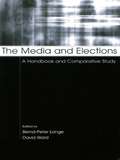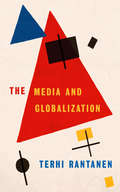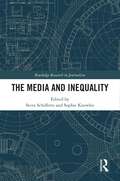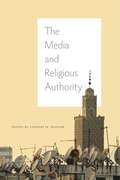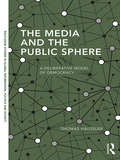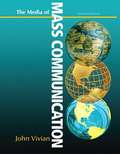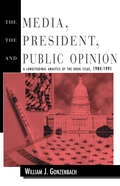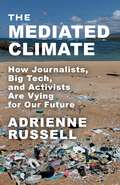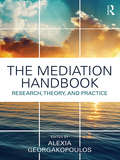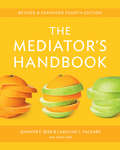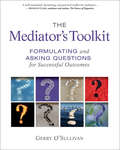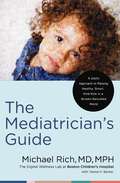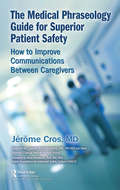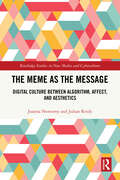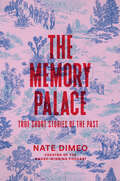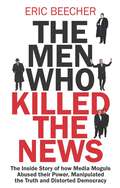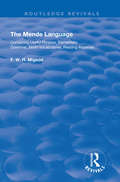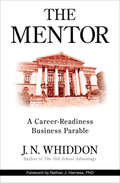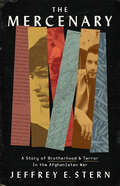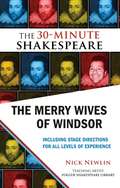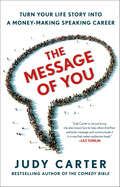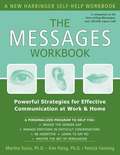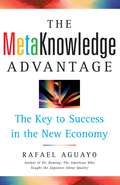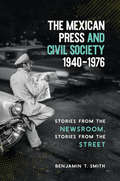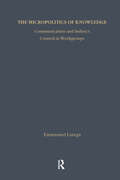- Table View
- List View
The Media and Elections: A Handbook and Comparative Study (European Institute for the Media Series)
by David Ward Bernd-Peter LangeThis comparative study brings together academics and practitioners who work in the field of media and elections to provide a set of national case studies and an analysis of the legal and regulatory frameworks that are employed by nation states to ensure that the media perform according to certain standards during election periods. In setting out the legal and regulatory framework each chapter provides an account of the socio-political conditions and media environment in each of the countries and subsequently details the laws that govern the print and broadcast media during election campaign periods. The countries included are France, Germany, Italy, Russia, South Africa, the United States, and the United Kingdom. A set of reflections by a Member of the European Parliament and a set of recommendations for good practice in media and elections are also included. Thus, the book is organized to provide a practical guide so that it can be used as a handbook.
The Media and Globalization
by Terhi Rantanen`This is a necessary and very original book that really does address the lack of attention to media in previous discussions about globalization' - James Lull, San Jose State University There is practically no globalization without media and communications. Yet this relationship is so obvious it is often overlooked. Rantanen challenges conventional ways of thinking about globalization and shows it cannot be understood without studying the role of the media. This book offers: - a clear and accessible overview of globalization and the pivotal role of the media - an introduction to the concepts and theories of globalization - empirical data on the production and consumption of media - a methodology for relating individual, local experiences to the global picture Rantanen has made this complex and huge subject very accessible by using personal histories and pictures to engage the reader. It will be invaluable to students in international media, cultural studies, communications and international relations.
The Media and Inequality (Routledge Research in Journalism)
by Steve Schifferes Sophie KnowlesThis book brings together a vast range of pre-eminent experts, academics, and practitioners to interrogate the role of media in representing economic inequality. It explores and deconstructs the concept of economic inequality by examining the different dimensions of inequality and how it has evolved historically; how it has been represented and portrayed in the media; and how, in turn, those representations have informed the public’s knowledge of and attitudes towards poverty, class and welfare, and political discourse. Taking a multi-disciplinary, comparative, and historical approach, and using a variety of new and original data sets to inform the research, studies herein examine the relationship between media and inequality in UK, Western Europe, and USA. In addition to generating new knowledge and research agendas, the book generates suggestions of ways to improve news coverage on this topic and raise the level of the debate, and will improve understanding about economic inequality, as it has evolved, and as it continues to develop in academic, political and media discourses. This book will be of interest to academics and practitioners alike in the areas of journalism, media studies, economics, and the social sciences, as well as political commentators and those interested more broadly in social policy.
The Media and Religious Authority
by Stewart M. HooverAs the availability and use of media platforms continue to expand, the cultural visibility of religion is on the rise, leading to questions about religious authority: Where does it come from? How is it established? What might be changing it? The contributors to The Media and Religious Authority examine the ways in which new centers of power and influence are emerging as religions seek to “brand” themselves in the media age. Putting their in-depth, incisive studies of particular instances of media production and reception in Asia, Africa, Latin America, and North America into conversation with one another, the volume explores how evolving mediations of religion in various places affect the prospects, aspirations, and durability of religious authority across the globe.An insightful combination of theoretical groundwork and individual case studies, The Media and Religious Authority invites us to rethink the relationships among the media, religion, and culture.The contributors are Karina Kosicki Bellotti, Alexandra Boutros, Pauline Hope Cheong, Peter Horsfield, Christine Hoff Kraemer, Joonseong Lee, Alf Linderman, Bahíyyah Maroon, Montré Aza Missouri, and Emily Zeamer, with an afterword by Lynn Schofield Clark.
The Media and the Public Sphere: A Deliberative Model of Democracy (Routledge Studies in Global Information, Politics and Society)
by Thomas HäusslerAt the heart of modern democracy lies the public sphere, which is most centrally shaped by those actors that integrate it discursively: the mass media. The media draw together the different strands of political debates; they grant access to some actors and arguments while excluding others and thus decisively mould the political process. In this book, Thomas Häussler examines how the media reflect and react to the wider context in which they are embedded. More specifically, he focuses on whether their discourse demonstrates systematic differences with regard to the two main public sphere types that they co-constitute, according to deliberative theory, focussing in particular on the work of Jürgen Habermas. The Media and the Public Sphere promotes a deeper and more detailed understanding of the political process by foregrounding the complex relationships between the media and the public discourse they constitute. It examines how the media co-create relationships of power, analyses the structure of these discursive networks and illuminates the effects that different deliberative coalition types have on political debates.
The Media of Mass Communication Eleventh Edition
by John VivianUpdated in its eleventh edition, The Media of Mass Communication engages readers in the pursuit of greater media literacy and provides accessible insight into the important issues that confront students as consumers and purveyors of mass media. Through exceptional coverage of contemporary media issues and trends, including the on-going transformations in mass media, this text balances the principles and foundations of media literacy with lively examples, streamlined coverage, and a robust media package.
The Media, the President, and Public Opinion: A Longitudinal Analysis of the Drug Issue, 1984-1991 (Routledge Communication Series)
by William J. GonzenbachUsing a broadened conceptualization of agenda setting, this volume's objective is to examine the drug issue from mid-1984 to mid-1991 to determine how drug-related issues and events -- both real and fabricated -- and the primary agendas drove the issue over time. Based on this objective, four questions are posed: * How did the media structure interpretations of drug issues and events? * How did the president structure public relations interpretations and presentations of issue and event information over time? * What were the interactions of the drug-issue agendas, the president's public relations agendas, the media, and the public, while controlling the policy agenda and a real-world measure of the severity of the drug problem? * How did the relationships of these agendas differ during the Reagan and Bush presidencies? These questions were addressed with detailed content analyses of the media agenda over time, the presidential public relations agenda over time, and a multivariate ARIMA analysis of the time series agendas. No previous studies to date have addressed and modeled these agendas simultaneously with ARIMA modeling methods.
The Mediated Climate: How Journalists, Big Tech, and Activists Are Vying for Our Future
by Adrienne RussellTo what extent does journalism deserve blame for the failure to address climate change over the last thirty years? Critics point out that climate coverage has often lacked necessary urgency and hewed to traditional notions of objectivity and balance that allowed powerful interests—mainly fossil fuel companies—to manufacture doubt. Climate journalism, however, developed alongside the digital media landscape, which is characterized by rampant misinformation, political polarization, unaccountable tech companies, unchecked corporate power, and vast inequalities. Under these circumstances, journalism struggled, and bad actors flourished, muddling messages while emissions mounted and societies struggled to avert catastrophe.The Mediated Climate explores the places where the climate and information crises meet, examining how journalism, activism, corporations, and Big Tech compete to influence the public. Adrienne Russell argues that the inadequate response to climate change is intertwined with the profound challenges facing the communications environment. She demonstrates that the information crisis is driven not only by technological changes but also by concentrated power that predates the rise of digital media companies. Efforts to improve climate coverage must take into account the larger social and material contexts in which journalism operates and the broader power dynamics that shape public discourse. Drawing on interviews with journalists and activists, Russell considers the ways recent movements are battling misinformation. She offers timely recommendations to foster engagement with climate issues and calls on readers to join in efforts to reshape the media landscape to better serve the public interest.
The Mediation Handbook: Research, theory, and practice
by Alexia GeorgakopoulosThe Handbook of Mediation gathers leading experts across fields related to peace, justice, human rights, and conflict resolution to explore ways that mediation can be applied to a range of spectrums, including new age settings, relationships, organizations, institutions, communities, environmental conflicts, and intercultural and international conflicts. The text is informed by cogent theory, state-of-the-art research, and best practices to provide the reader with a well-rounded understanding of mediation practice in contemporary times. Based on four signature themes—contexts; skills and competencies; applications; and recommendations—the handbook provides theoretical, applicable, and practical insight into a variety of key approaches to mediation. Authors consider modern conflict on a local and global scale, emphasizing the importance of identifying effective strategies, foundations, and methods to shape the nature of a mediation mindfully and effectively. With a variety of interdisciplinary perspectives, the text complements the development of the reader’s competencies and understanding of mediation in order to contribute to the advancement of the mediation field. With a conversational tone that will welcome readers, this comprehensive book is essential reading for students and professionals wanting to learn a wide range of potential interventions for conflict.
The Mediator's Handbook
by Caroline C. Packard Eileen Stief Jennifer E. BeerThe popular The Mediator's Handbook presents a time-tested, adaptable model for helping people work through conflict. Extensively revised to incorporate recent practice and thinking, the accessible manual format lays out a clear structure for new and occasional mediators while offering a detailed, nuanced resource for professionals. Starting with a new chapter on assessing conflict and bringing people to the table, the first section explains the process step by step, from opening conversations and exploring the situation through the phases of finding resolution--deciding on topics, reviewing options, and testing agreements. The "Toolbox" section details the concepts and skills a mediator needs in order to: Understand the conflict Support the people Facilitate the process Guide decision-making Throughout the book, the emphasis is on what the mediator can do or say now, and on the underlying principles and core methods that can help the mediator make wise choices. Long a popular course textbook for high schools, universities, and training programs, The Mediator's Handbook is also a valued desk reference for professional mediators and a practical guide for managers, organizers, teachers, and anyone working with clients, customers, volunteers, committees, or teams. Jennifer E. Beer, PhD, mediates organizational conflicts, facilitates meetings, and offers related workshops, regularly teaching a negotiation course at Wharton (University of Pennsylvania). Caroline C. Packard, JD led Friends Conflict Resolution Programs for fifteen years and is an organizational conflict response specialist and mediator based in Philadelphia, Pennsylvania. Eileen Stief developed the mediation process presented in the Handbook, training a generation of mediators to work with community, multi-party, and environmental disputes.
The Mediator's Toolkit: Formulating and Asking Questions for Successful Outcomes
by Gerry O'Sullivan“Dives deep into the psychology of information and emotion in conflict situations . . . Highly recommended for facilitators and negotiators as well as mediators.” —Jennifer Beer, author of The Mediator’s Handbook and negotiation instructor at Wharton School, University of PennsylvaniaKnowing how to formulate and ask incisive questions to get to the core of a conflict, challenge entrenched thinking, and shift perspectives is the key to successful conflict resolution. The Mediator’s Toolkit employs the author’s powerful “S Questions Model” to provide readers with the skills and tools to do just that. It addresses four dimensions of successful questions for mediation: the subject matter dimension, the structure dimension, the information-seeking dimension, and the shifting thinking dimension. The toolkit clearly explains:The theory behind each question type, including exploration of relevant neuroscience and psychologyThe purpose of different types of questionsHow the questions workWhen to use different types of questionsHow to build and apply questions to mediation in a non-threatening wayThis essential practical guide will radically sharpen, focus, and improve the questioning skills of qualified mediators, students, lecturers, trainers, and those using questions to challenge and effect change, in any context.
The Mediatrician's Guide: A Joyful Approach to Raising Healthy, Smart, Kind Kids in a Screen-Saturated World
by Michael Rich, MD, MPHGain the confidence you need to raise a child well in the digital age.In this positive, science-based approach, Dr. Michael Rich addresses your questions and concerns about your childrens&’ screen time and media use. The Mediatrician&’s Guide empowers you to guide your family toward smart and healthy digital choices.Known as the &“Mediatrician&” due to his acclaimed work as a pediatrician, child health researcher, and children&’s media specialist, Dr. Rich presents a compassionate and encouraging look at the reality of growing up in a screen-saturated world. You won&’t find fearmongering here—just accessible explanations, case studies, and practical tips to help your kids thrive in a technology-rich environment and emerge as happy, well-informed, empathetic adults.Features include:Ask the Mediatrician: Questions and answers based on Dr. Rich&’s long-running advice column and podcastMedia Rx: Prescriptive content based on insights from the Digital Wellness Lab and the Clinic for Interactive Media and Internet DisordersYou Can: Straightforward instructions for what you can do to guide your child in the digital landscapeDigital Wellness Primer: A one-stop resource for actionable advice that you can customize for your family&’s specific needsBacked by evidence as well as decades of professional and personal practice, The Mediatrican's Guide will give you peace of mind and your kids much-needed tools to navigate the digital environment in a way that reduces the risks to their physical and mental health and their emotional and social development..&“A caring, wise, and joyful guide to the possibilities and the perils of our increasingly more digital existence.&”—Marlo Thomas, activist, actor, and author&“This book is a must-have and will soon become your best friend, full of daily tips and long-lasting wisdom.&”—Sanjay Gupta, MD,associate professor of neurosurgery, Emory, and chief medical correspondent, CNN
The Medical Phraseology Guide for Superior Patient Safety: How to Improve Communications Between Caregivers
by Jerome CrosIn patient care, inaccuracy often leads to error: the patient does not receive the right medication, the nurse is mistaken about the patient, the doctor is mistaken about the condition. Human error in care is now a well-known occurrence, and medicine has borrowed many tools from aviation to improve safety, such as simulation training, limitation of working time, use of checklists, and so forth. All these tools contribute to improving human factors in healthcare. Often due to the lack of communication between professionals, healthcare accidents are avoidable. The only solution is the standardization of communication through phraseology. But make no mistake, the subject of communication is vast and much more complex to teach than we imagine. Communication is not only an exchange of words, of meaning, of a sender-receiver scheme; it also carries the essence of all social and cooperative life by its tone, by its moment, by the listening and availability it demands from the other person, by the words chosen, by those not said voluntarily, and those referred to as “tacit” (what we no longer need to say but the other guesses). The Medical Phraseology Guide for Superior Patient Safety: How to Improve Communications Between Caregivers, through concrete and proven examples, gives readers the keys to improve communication with their healthcare colleagues. The author proposes 26 rules that are detailed and easy applicable in everyday life. These rules are inspired by the tools and checklist developed and used by commercial airline pilots. Today, more than ever, caregivers face new situations, and they have to adapt to caring for an unusual number of patients, sometimes in new environments. Given this new environment, it becomes clear that teamwork and communication are indispensable tools for improving efficiency and safety in patient care.
The Meme as the Message: Digital Culture Between Algorithm, Affect, and Aesthetics (Routledge Studies in New Media and Cyberculture)
by Joanna Nowotny Julian ReidyThis book sheds light on the phenomenon of memes, covering everything from pandemic humour to far-right propaganda, from feminist memes to algorithmic censorship. Memes are far more than light entertainment - they are complex cultural artefacts that play a role in politics, in art, and in platform economics.Taking a cultural studies perspective, the authors analyse individual memes in entertaining case studies, systematising their findings in order to redefine this digital form of communication. Chapters connect memes with other digital phenomena such as trolling, and combine extensive close readings of exemplary individual memes with regards to form and aesthetics with an acute awareness of power dynamics and other context phenomena surrounding memes. The book develops an innovative theoretical approach that presents the term “memesis” to capture the very specific quality of meme production and reception as a form of collective creative rewriting of a template in accordance with algorithmic logic.Offering an important contribution not only to the still young field of meme studies but also to the general negotiations of questions around digital literacy, this book will interest not only scholars and students of digital media, visual communication, cultural studies, and media and politics but anyone with a keen interest in digital culture - and how it shapes our lives.
The Memory Palace: True Short Stories of the Past
by Nate DiMeoIncredible true stories reveal strange new magic in American history in this wondrous first book from the creator of the award-winning podcast The Memory Palace.&“One doesn&’t often find the words imagination and history in the same sentence. Nate DiMeo has forever woven them together. The Memory Palace wants you to linger, to stay awhile, and find a deeper meaning both in the stories of the past and perhaps in your own life as well.&”—Ken BurnsThe Memory Palace is a collection of crystalline historical tales that read like luminous short fiction and, like Nate DiMeo&’s acclaimed podcast of the same name, conjure lost moments and forgotten figures who are calling out across time to be remembered.Space capsules filled with fruit flies and future senators. A socialite scientist who gives up her glamorous life to follow love and the elusive prairie chicken. A boy genius on a path to change the world who gets lost in the theoretical possibilities of streetcar transfers. An enslaved man who steals a boat and charts a course that leads him to freedom, war, and Congress. A farmer&’s wife who puts down her butter churn, picks up the butter, and becomes an international art star. An amusement park glowing at the water&’s edge when electric lights are a brand-new thing. This cabinet of curiosities teems with wonder.For fifteen years, Nate DiMeo has turned to the past to make sense of the way we live today, finding beauty and meaning in history&’s dustier corners, holding things up to the light and weaving facts, keen insight, wit, and poignant observation into unforgettable tales. With new stories and treasured favorites from the beloved podcast assembled alongside dynamic illustrations and archival photographs for the first time, enchantment awaits you.
The Men Who Killed the News: The inside story of how media moguls abused their power, manipulated the truth and distorted democracy
by Eric BeecherCrikey owner and ex-News Corp and Fairfax editor lifts the lid on the abuse of power by media moguls – from William Randolph Hearst to Elon Musk – and on his own unique experience of working for (and being sued by) the Murdochs. What&’s gone wrong with our media? The answer: its owners. From William Randolph Hearst to Elon Musk, from the British press barons to colonial upstarts Conrad Black and Rupert Murdoch, media proprietors have manipulated the news to accumulate wealth and influence as they meddled with democracy. Eric Beecher knows the news business from bottom to top. He has been a journalist, editor and media proprietor (of Text Media and Crikey), with the rare distinction of having both worked for and been sued (unsuccessfully) by the Murdochs. This book reveals the distorted role of the media moguls of the past two centuries: their techniques, strategies, behind-closed-doors machinations, and indulgent lifestyles. It explains how they have exploited the shield of the freedom of the press to undermine journalism – and truth. In an era of fake news, AI and misinformation, this is democracy&’s chillingly important story: how a small coterie of flawed and narcissistic moguls created a shadow of power that has contributed to making the media an agent of mistrust.
The Mende Language: Containing Useful Phrases, Elementary Grammar, Short Vocabularies, Reading Materials (Routledge Revivals)
by F.W.H. MigeodFirst published in 1908, this volume emerged in the midst of the British Protectorate of Sierra Leone. The author, F.W.H. Migeod, studied the Mende nation in eastern Sierra Leone and followed the example of the grammar (1882) and vocabulary (1884) published by Dr. Schoen in using the southern form of the Mende language. Beginning with an introduction to the recent history, culture and characteristics of the Mende nation and Sierra Leone, this volume covers useful phrases, grammar, vocabulary and example reading materials including stories and songs collected from native speakers.
The Mentor: A Career-Readiness Business Parable
by J.N. WhiddonA student discovers the 12 Keys for Professional Success in this modern business parable by the acclaimed author and entrepreneur.The semester has begun, and Professor Johnathan Daniels welcomes his next batch of students into his classroom. He teaches the capstone Business Communications course at State U, one of the most valuable classes a student can take. As senior Aaron Woods takes his seat, he has no idea the wealth of knowledge, skills, and communication tools he’s about to receive that will help him conquer life after graduation.Dr. Daniels’ curriculum consists of his “12 Keys to Professional Success,” which offer help and guidance through any career-related obstacle one might encounter. As Aaron and his class make their way through the 12 Keys, they’ll gain wisdom and learn how to master essential principles—such as establishing rapport with others, time management, interview skills, dressing professionally, and more.Grab a seat: class is about to begin.
The Mercenary: A Story of Brotherhood and Terror in the Afghanistan War
by Jeffrey E SternA thrilling and emotional story about the bonds forged in war and good intentions gone wrong. In the early days of the Afghanistan war, Jeff Stern was scouring the streets of Kabul for a big story. He was accompanied by a driver, Aimal, who had ambitions of his own: to get rich off the sudden infusion of foreign attention and cash. In this gripping adventure story, Stern writes of how he and Aimal navigated an environment full of guns and danger and opportunity, and how they forged a deep bond. Then Stern got a call that changed everything. He discovered that Aimal had become an arms dealer, and was ultimately forced to flee the country to protect his family from his increasingly dangerous business partners. Tragic, powerful, and layered, The Mercenary is more than a wartime drama. It is a Rashomon-like story about how politics and violence warp our humanity, and keep the most important truths hidden.
The Merry Wives of Windsor: The 30-Minute Shakespeare
by Nick NewlinPlanning a school or amateur Shakespeare production? The best way to experience the plays is to perform them, but getting started can be a challenge: The complete plays are too long and complex, while scene selections or simplified language are too limited."The 30-Minute Shakespeare" is a new series of abridgements that tell the "story" of each play from start to finish while keeping the beauty of Shakespeare's language intact. Specific stage directions and character suggestions give even inexperienced actors the tools to perform Shakespeare with confidence, understanding, and fun!This cutting of THE MERRY WIVES OF WINDSOR begins with one of Shakespeare's favorite fat knights, Sir John Falstaff, announcing his intention to woo both Mistress Ford and Mistress Page simultaneously, to the delight of his cohorts Bardolph, Pistol, and Nym, who then decide to double-cross Falstaff. The characters' movements on stage are clearly denoted so that even inexperienced actors can give the scenes life: Robin is nearsighted, Bardolph is a drunk who tries to juggle, and Pistol and Nym are constantly jostling for position. Other key moments include the hilarious wooing of Mistress Ford by Falstaff and the hysterical concealment of Falstaff in the laundry basket. The cutting ends in the woods with Falstaff dressed as a stag, being tormented by fairies for his comeuppance.The edition also includes an essay by editor Nick Newlin on how to produce a Shakespeare play with novice actors, and notes about the original production of this abridgement at the Folger Shakespeare Library's annual Student Shakespeare Festival.
The Message of You: Turn Your Life Story into a Money-Making Speaking Career
by Judy CarterA step-by-step handbook that teaches readers to find the extraordinary stories tucked deep within them to make a difference in the lives of others—and to get paid—as a motivational speakerTHE MESSAGE OF YOU begins with a simple belief - that your greatest speech already exists and that it has already been delivered in front of a live audience masterfully and powerfully by you. Best-selling author and international comic, Judy Carter sets out to prove that THE MESSAGE OF YOU is in the advice you give to your friends; in the lessons you teach your children; in the stories you tell your family. It's expressed through the volunteer work you do, the way you run your business, the way you turned your messes into successes. THE MESSAGE OF YOU is a distillation of all of your experiences, both personal and professional, that form the narrative meaning of your life. A meaning that you can develop into a well-written, funny speech to inspire audiences, enhance your current profession, and launch a successful money making career as a professional speaker. In Part One of the book, Judy leads you through a series of in-depth exercises meant to mine your personal and professional experiences for stories that establish your qualifications, your problem/solutions, your action steps and your methodology. In Part Two, Judy has created a six-step structure for writing an entertaining and informative speech, guiding you through each step in detail. But the real bonus of THE MESSAGE OF YOU is that Judy is a comic. Her "Comedy Pass" chapter takes you through simple but effective comedy writing techniques that will transform even a flat PowerPoint snoozer into a knee-slapping showstopper of a keynote. Once your speech is well-written and funny, Judy takes you through Part Three, teaching you how to take your message to the masses with inexpensive but essential marketing tips. The Message of You offers an accessible approach, big picture guidance, and nitty-gritty nuts and bolts of sound advice. Judy has been a comedy and speaking coach for over twenty years. She's a firm believer that how you present your ideas is just as important as the ideas themselves. She knows that humor and strong content are the missing ingredients in most speeches and her book, THE MESSAGE OF YOU helps you discover both your message and your comedic voice by taking you through the same process she uses to coach her private clients.
The Messages Workbook: Powerful Strategies For Effective Communication At Work And Home
by Patrick Fanning Martha Davis Kim PalegSimply put, skill at communicating with others is the single largest determinant of anyone's happiness, and success. Rewarding and lucrative careers, strong and lasting friendships, meaningful and satisfying romance all hang on this one uniquely human ability. You need strong communication skills to survive. The better able you are to communicate with others, the happier and more successful you will be.
The Metaknowledge Advantage
by Rafael AguayoIn the tradition of the bestselling Intellectual Capital, internationally recognized management and quality expert Rafael Aguayo shows how integrated mastery of many areas of knowledge -- MetaKnowledge -- can give corporate managers an edge, no matter what the future has in store. In today's world, the basis of economic power and wealth is rapidly shifting from physical resources to intellectual resources. Former powerhouses like U.S. Steel are now minor players, while modern giants such as Microsoft dominate industries that didn't even exist twenty-five years ago. The economy undergoes wild fluctuations. The Internet boom has come and gone. Through globalization, international boundaries are becoming less important every day. In such a dramatically changing environment, the management philosophy that endures must be based on principles that transcend daily occurrences and swings in the market. That's where MetaKnowledge comes in. Rafael Aguayo brings years of firsthand consulting experience to this book and galvanizes it with an impressive yet accessible body of academic study. A disciple of W. Edwards Deming, Aguayo studied with the man who brought quality to the Japanese. He has since expanded his field of expertise to encompass many subjects that contribute to successful business strategies, no matter what the industry. In The MetaKnowledge Advantage, Aguayo gives American managers an advantage by helping them break out of their narrow fields of expertise, synthesizing areas of knowledge as diverse as ecology, psychology, statistics, chaos theory, self-actualization, and the theory of multiple intelligences. Drawing on the work of Walter Shewhart (the father of Statistical Quality Control), W. Edwards Deming, Carl Jung, James Lovelock, Bertrand Russell, and many other luminaries, The MetaKnowledge Advantage offers a comprehensive -- and extremely flexible -- strategy for good management and ethical behavior in any industry.
The Mexican Press and Civil Society, 1940–1976: Stories from the Newsroom, Stories from the Street
by Benjamin T. SmithMexico today is one of the most dangerous places in the world to report the news, and Mexicans have taken to the street to defend freedom of expression. As Benjamin T. Smith demonstrates in this history of the press and civil society, the cycle of violent repression and protest over journalism is nothing new. He traces it back to the growth in newspaper production and reading publics between 1940 and 1976, when a national thirst for tabloids, crime sheets, and magazines reached far beyond the middle class.As Mexicans began to view local and national events through the prism of journalism, everyday politics changed radically. Even while lauding the liberty of the press, the state developed an arsenal of methods to control what was printed, including sophisticated spin and misdirection techniques, covert financial payments, and campaigns of threats, imprisonment, beatings, and even murder. The press was also pressured by media monopolists tacking between government demands and public expectations to maximize profits, and by coalitions of ordinary citizens demanding that local newspapers publicize stories of corruption, incompetence, and state violence. Since the Cold War, both in Mexico City and in the provinces, a robust radical journalism has posed challenges to government forces.
The Micropolitics of Knowledge: Communication and Indirect Control in Workgroups (Communication & Social Order)
by Emmanuel LazegaFor many years Emmanuel Lazega has explored communication behavior and decision-making processes of small workgroups within larger organizations. To account for the knowledge claims of members of those groups, and for the ways in which such claims are legitimated collectively and translated into action, he presents a theory of the interactive elaboration of information on which decisions are based.
